It seems that at least as of 1994 when the 2nd edition of Glaw & Vences's field guide was published, there hadn't been much study of the herps in the forest around Anjajavy. Many of the species I saw there aren't shown in that location in Glaw & Vences's range maps, and at least two of them are species that don't seem to be listed in the book at all.
The only way to reach Anjajavy is by small plane. Here's the one we took from Nosy Be.
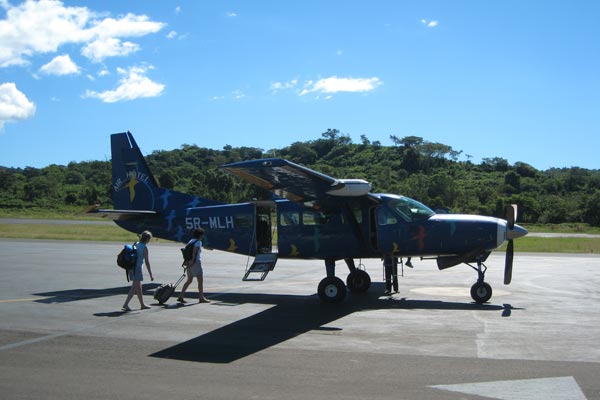
The dirt + grass patch that passes for a runway sits next to a small "International Airport" building. The Anjajavy folks like to think of it as an entity entirely separate from the rest of Madagascar. They even use a different time zone than the rest of Madagascar. They had some explanation for this involving convenience for the staff, but it just seemed kinda silly to us. From the airstrip, it's about a 30 minute truck ride through the forest to reach the main resort area.
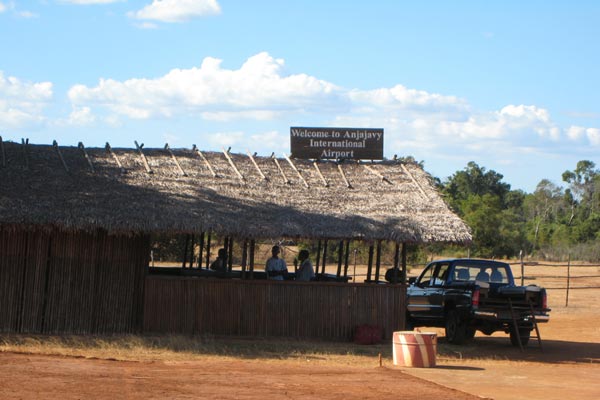
Here's our room, just above the Indian Ocean beach. As we were arriving, my wife joked that this place was so luxurious compared to the other places we had stayed that it probably had air conditioning. Imagine our surprise when it actually did! Creepy!
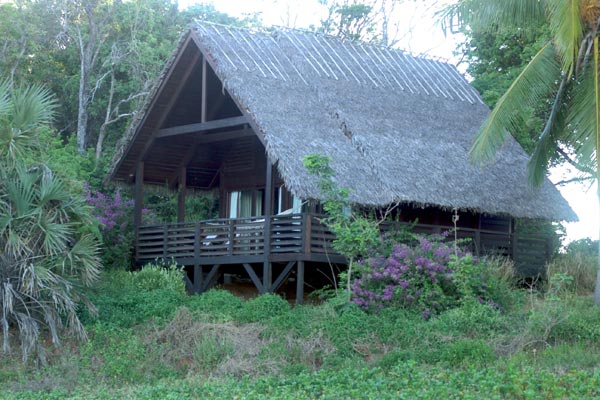
And here's the view of the Indian Ocean from the deck of our room, at sunset.
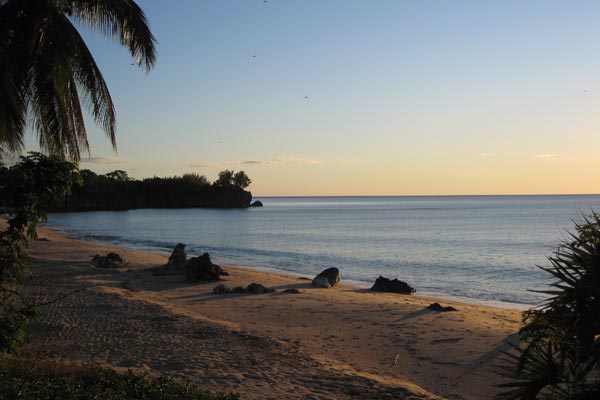
When we first arrived, we were seated around a table outside the bar and given cold fruity drinks. We thought we must have taken a wrong turn and ended up in Hawaii or something. Still, the cold fruity drinks were delicious. And as we were sucking them down, I spotted a new lizard on a nearby palm tree. We soon discovered that the area was crawling with Oplurus cuvieri, the most well-known and widespread of the Madagascar iguanian lizards. Here's a little baby and a large adult, both from the main resort grounds. We also saw these lizards on rocks and trees on the beaches, and in the forest.
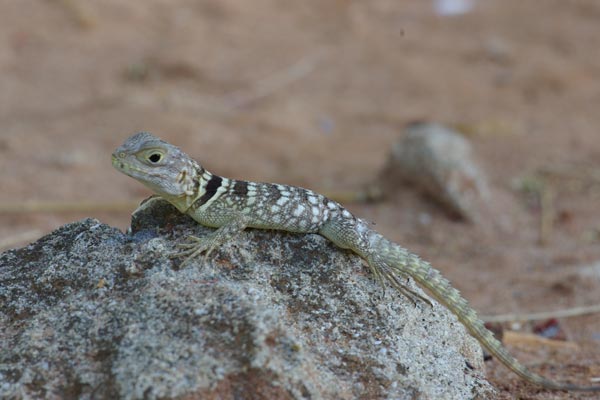
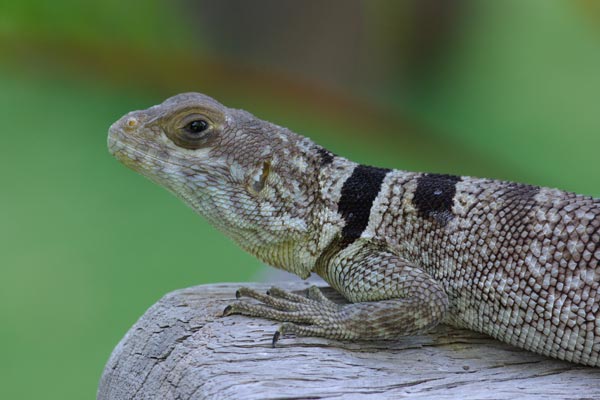
The skink Mabuya elegans was common at the fringes of the forest and near the beaches.
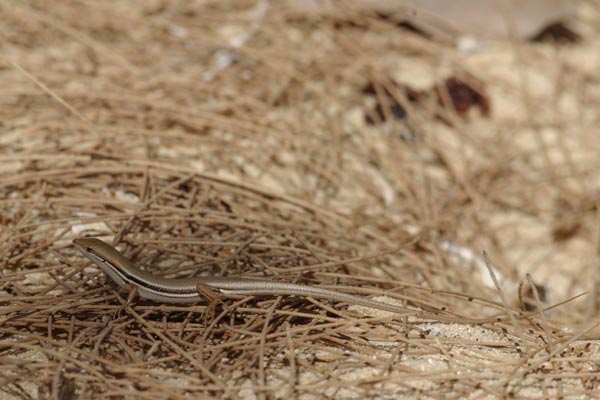
I saw a few individuals of another skink in the forest. This is one of the species that don't seem to be listed in Glaw & Vences at all. It seems to be in the Mabuya aureopunctata complex, but the markings aren't as distinct as in that species, and that species isn't shown anywhere near this far north. Since G&V 2nd edition came out, a number of new skinks have been described in Madagascar, but I haven't been able to find enough info on the web to tell whether this might be one of those, or yet another undescribed species.
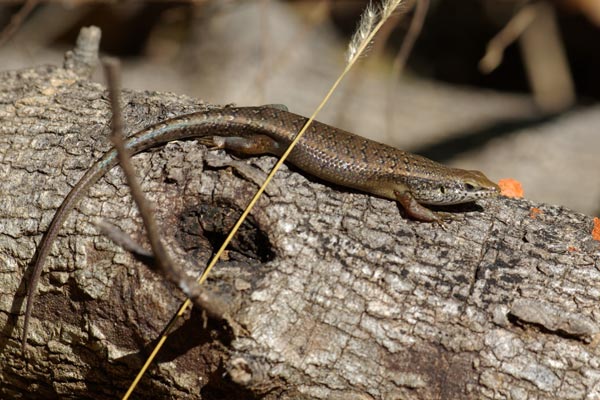
Anjajavy had a beautiful garden area centered around a carefully-maintained pond. A couple of species of Phelsuma geckos lived on some of the plants near the pond, especially the Ravenella palms. Unlike Beery from Nosy Komba, the Phelsuma laticauda here were very shy, and this is the only photo I managed to get of a very young one.
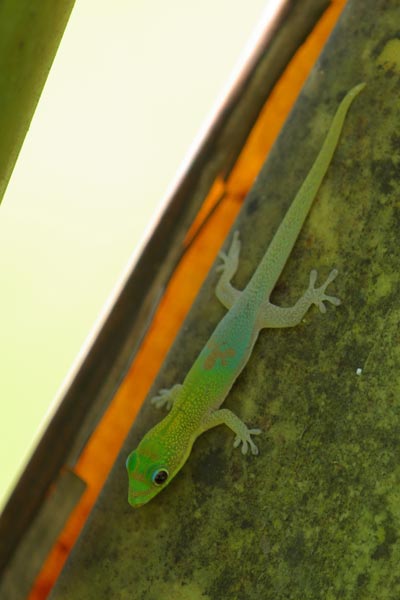
Anjajavy is at the heart of the intergrade zone between two subspecies of the largest day gecko, Phelsuma madagascariensis. P. m. grandis is bigger and brighter, and P. m. kochi is smaller with more muted colors. As far as I could tell all of the Phelsuma I saw other than P. laticauda were these intergrades, but it's possible that some of them are yet another species.
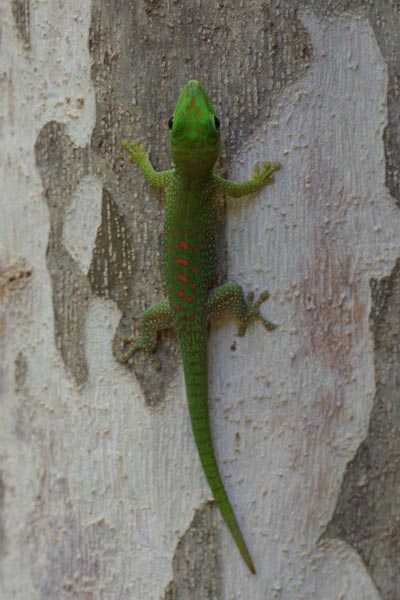
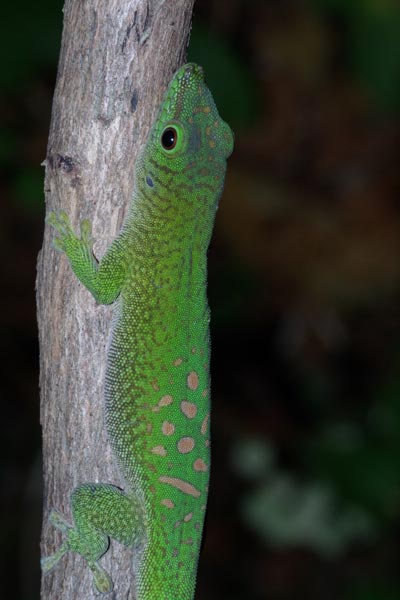
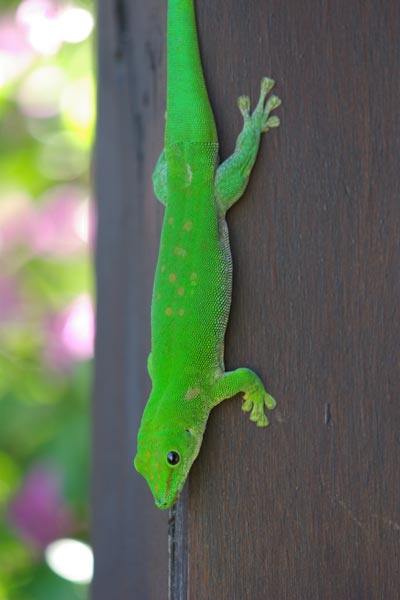
I came across this house gecko sleeping at night on the leaves of one of the plants near the pond.
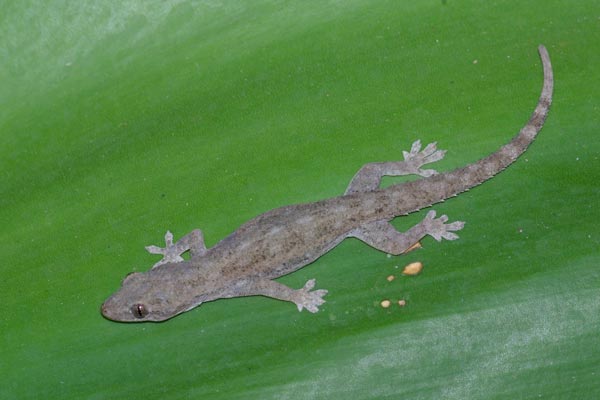
To round out the Anjajavy geckos, here are three Lygodactylus from three different areas around Anjajavy. G&V don't show any Lygodactylus in this exact area. My best guess is that these are L. tolampyae, which G&V show with a fairly broad range on the west coast, ending a little south of Anjajavy.
This little baby was playing hide-and-seek with me for quite awhile at dusk. It had excellent camouflage against the tree trunk, and was very difficult to see in the ebbing light.
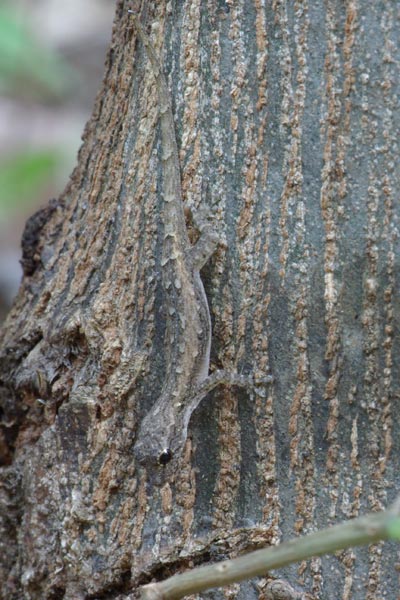
These two adults were sleeping at night in the forest.
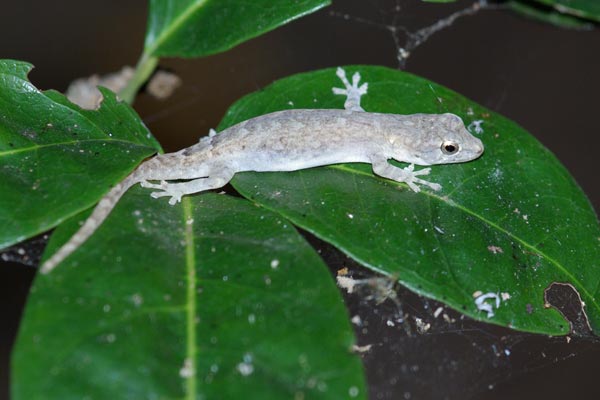
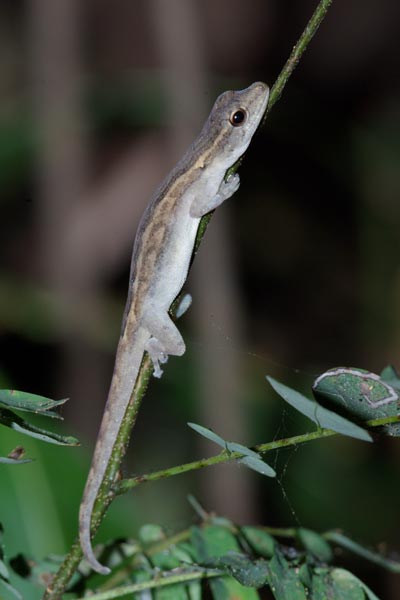
At Anjajavy, unlike the other forests we visited, we usually went hiking by ourselves, without any guide. There was an official guide who led a couple of group hikes each day, but we only joined in on one of those (which I'll mention later). Hiking by ourselves was a relaxing change, but it did mean that we were without the wildlife-spotting expertise eyes of the local guides. Finding chameleons was therefore much more difficult, but also extra satisfying.
Here's one we saw in the typical nighttime sleeping position. Although this looks very much like the well-known Furcifer pardalis, that species isn't known from this far south on the west coast. I believe it is instead a female Furcifer angeli. The males have longer rostral protuberances (i.e., silly-looking noses), but the females look remarkably similar to Furcifer pardalis. The ranges of the two species are not known to overlap.
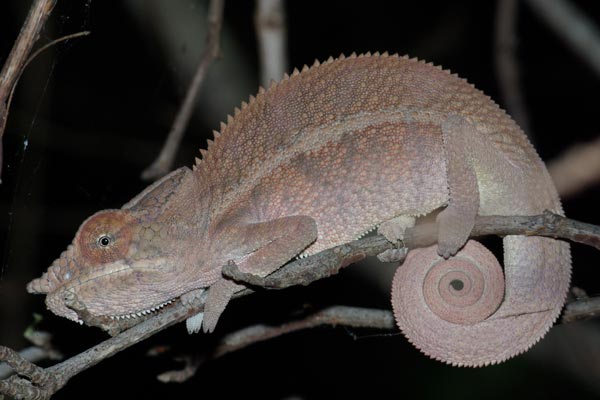
The only other chameleons we got a good look at Anjajavy were our by-now-old-friends F. oustaleti. (I say "got a good look at" rather than "saw" because we saw two chameleons being bashed around by mean, mean birds, and we didn't see them closely enough to tell what species they were.) Here's a stretched-out F. oustaleti trying to conceal itself at night behind a thin twig. Somebody should tell the chameleons that this doesn't really work very well as camouflage.
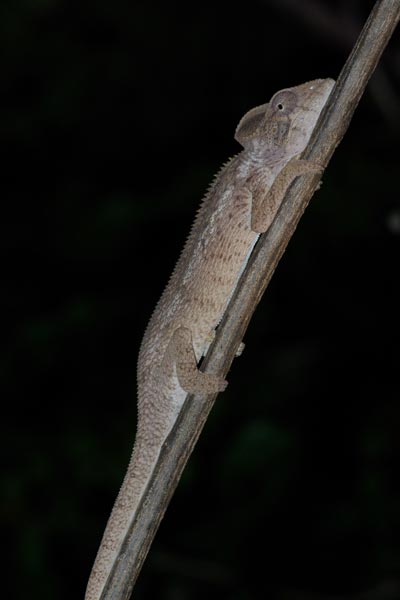
One afternoon I took a path through the forest that ended up at a beautiful rocky beach. As I approached the beach, I noticed that a decent-sized bush had managed to thrive atop a rough hunk of rock, about four feet above the beach sand. Something about this bush caught my eye. Here's what it looked like as I approached the beach.
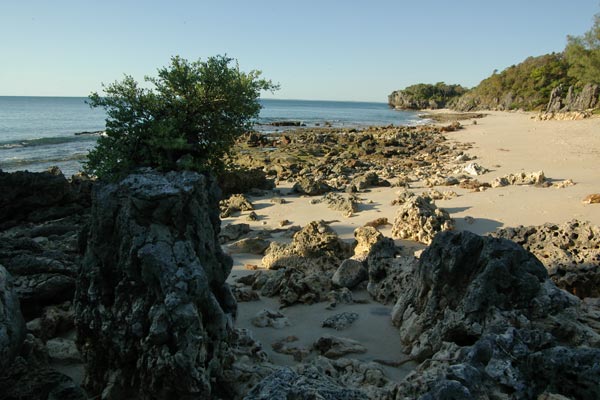
And here's what I found lurking in the bush when I got close.
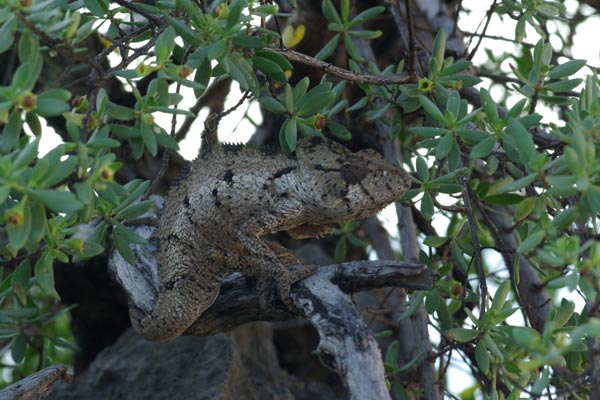
The next morning we took the same path out to the same beach and looked in the bush, but alas it was devoid of chameleons. However, my wife spotted this one looking simultaneously guilty and inconspicuous a few feet away, on one of the beach rocks. I would bet that it's the same individual.
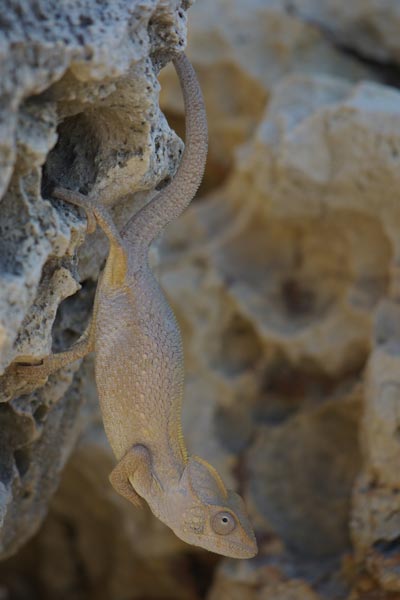
The previously-mentioned pond was, unsurprisingly, the home of some frogs. We found (at least) three species. The first frog I came across was this peculiar flattened one hunkered down in the grass about a foot from the pond's edge. At first, my wife accused it of being dead, but it was perfectly fine.
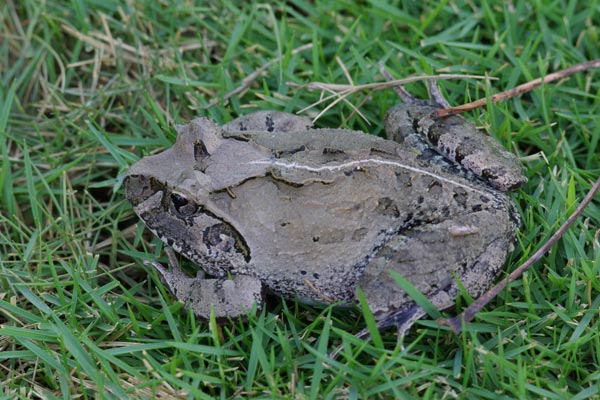
Each night I took another tour of the pond. I saw a handful of frogs in the afternoon, but there were dozens at night, hopping all over the grass, perched in the pondside plants, and floating in the water. Here's another of the same toad-like type at night in the grass.
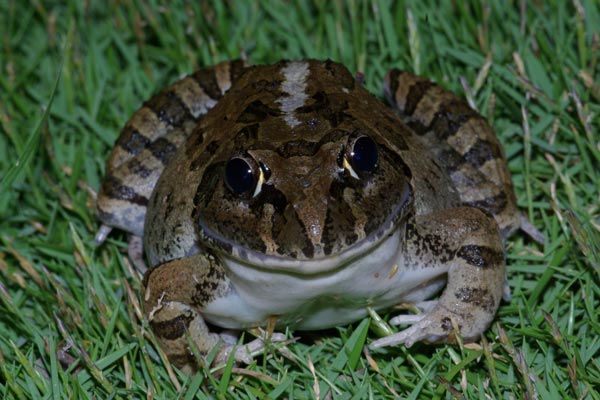
The majority of the frogs were the fairly nondescript treefrog Boophis tephraeomastyx. Here's the first one I came across, looking essentially like California's most common frog Pseudacris regilla.
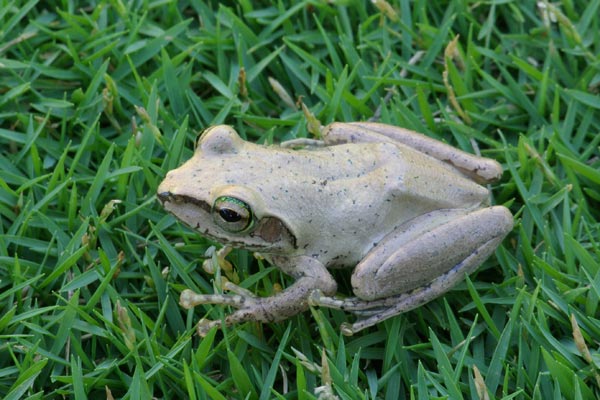
Here's a somewhat larger individual perched on a reed in the pond.
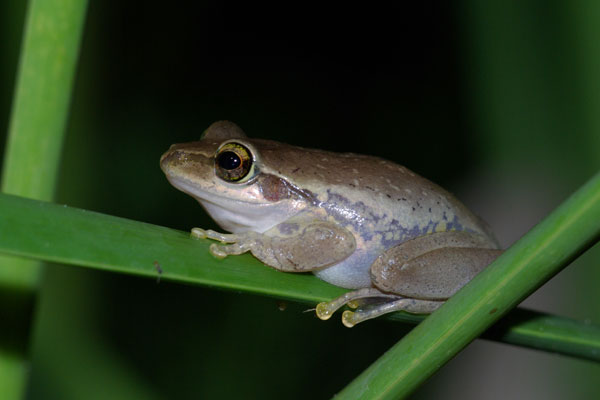
And one more, afloat.
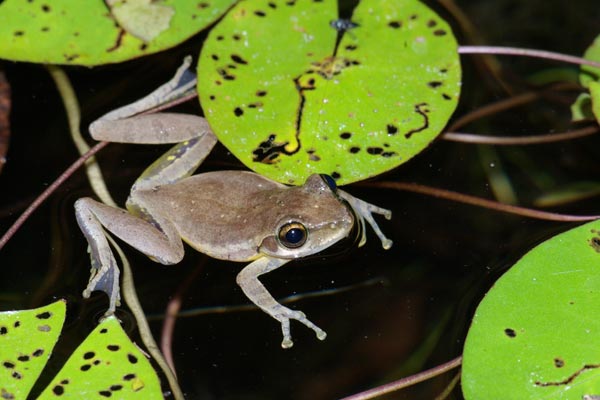
The third type of frog we saw is a bit of a puzzle. At first I thought it was the common frog Ptychadena masacareniensis that we had seen in a number of places. But a few individuals had a bright green dorsal stripe, which I hadn't seen on this species before, and which isn't mentioned in my books. Also, I later realized that Ptychadena masacareniensis is fairly small, maxing out at about 70mm long. I'm pretty sure that these guys were longer than that, closer to 100mm. My best guess is that it's Hoplobatrachus tigerinus, which has the distinction of being the only known non-native Madagascar frog, according to Glaw & Vences. However, I haven't found any mention of a bright green dorsal stripe in H. tigerinus either.
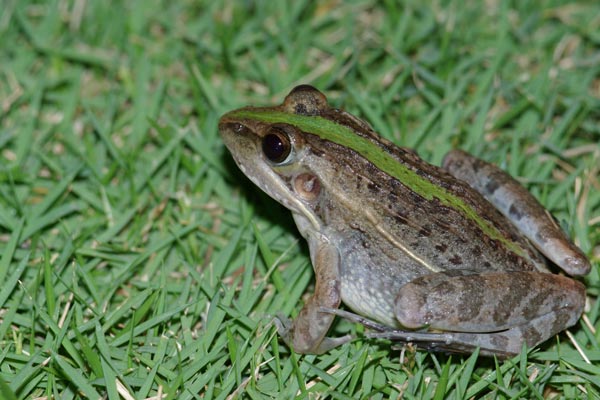
Each night we'd find a few fat and happy snakes coiled at the edge of the pond, practically drooling at the bountiful froggy prey.
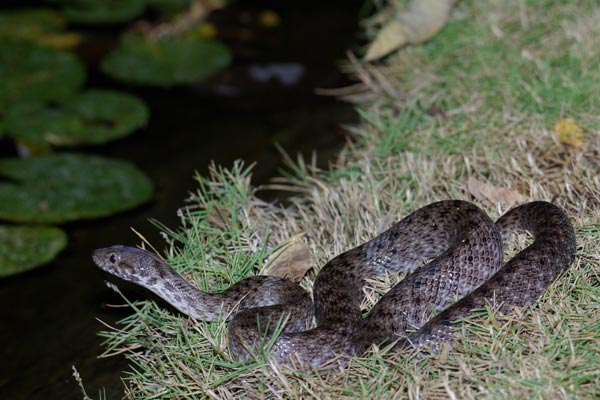
The most common snake at Anjajavy was this small colubrid. We saw about a dozen of them in a couple of days. This one was the first we came across, a youngster basking in the morning on a dirt path. When disturbed, these snakes could escape incredibly quickly with a violent thrashing motion.
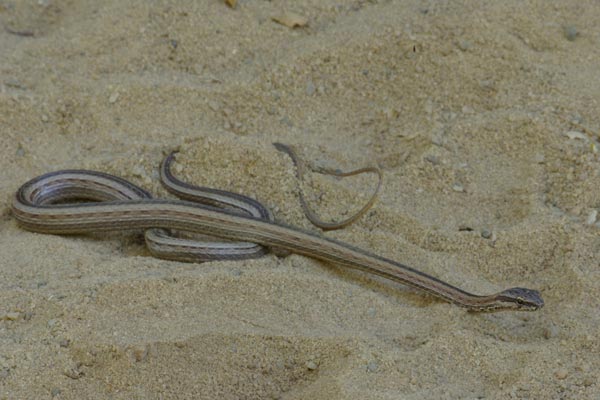
Here's a well-fed adult of the same species, a little more than two feet long.
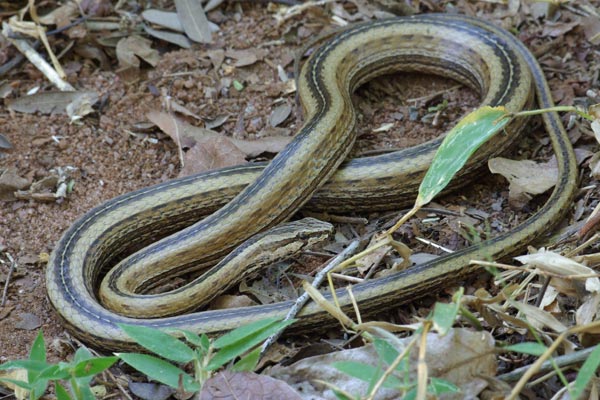
This next species reminded me of Coluber constrictor. It's got the large eyes of a fast diurnal surface-active serpent. Here's a little baby that was making its way through the grass a few feet from the outdoor bar area.
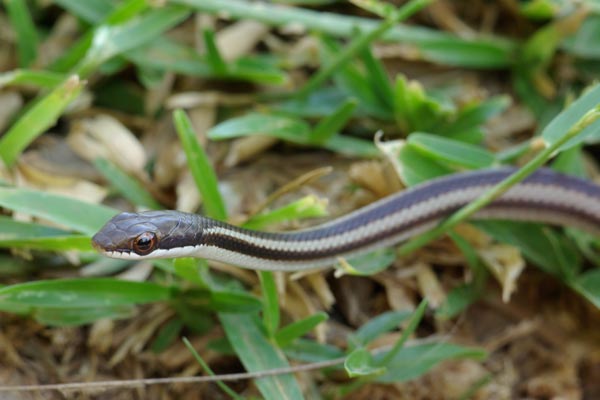
And here's an adult sneaking its way through the forest.
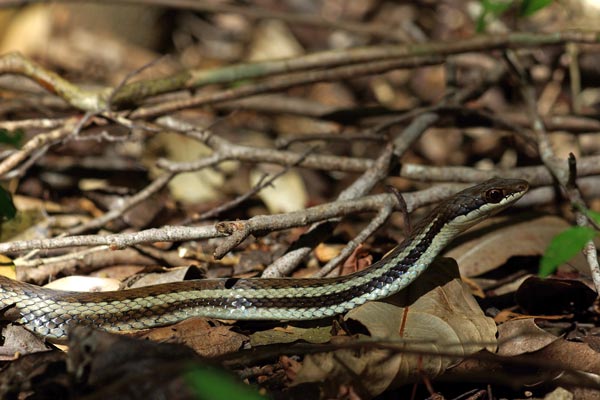
One afternoon we joined one of the planned group hikes led by a local guide, because it was going to a cave containing a fossil lemur skull and you weren't allowed into the cave unless you went with the local guide. To get into the cave, we first had to climb about ten feet down a vertical ladder into a fairly small chamber. Then we had to take turns climbing through a very low-overhead passageway in the dark to reach the fossil (armed with flashlights of course). On a wall of this passageway, this marvelous snake was coiled up, obviously digesting a large meal. A few of the people on the group hike were too nervous to climb down the ladder, and a few more were too nervous to pass within a few feet of this snake. Back in my 4th post about the Masoala Peninsula on the east coast, I showed a head-only shot of a snake we had discovered in my sister's bathroom. This is its west coast equivalent species, with the same yellow-to-deep-red coloration.
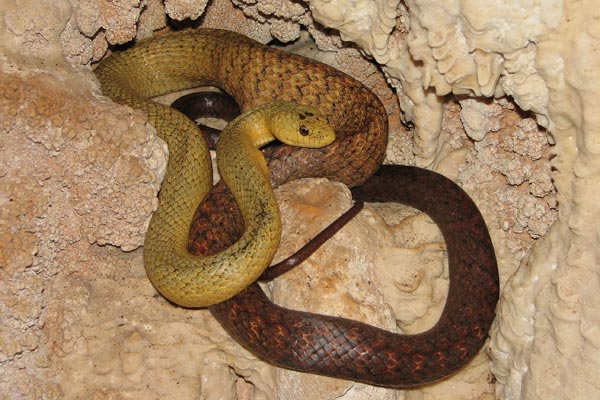
And here's the fossil lemur skull that the snake was inadvertently guarding.
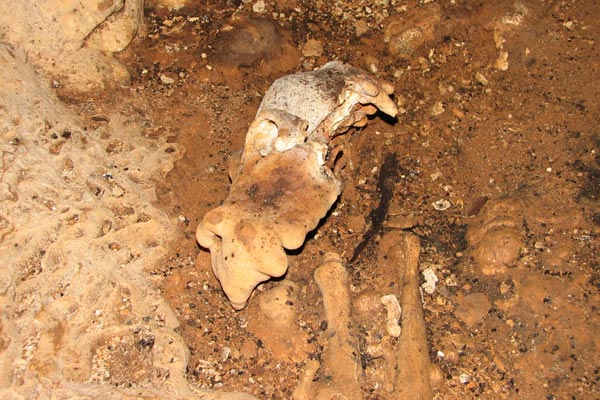
The last type of snake we saw at Anjajavy was an arboreal nocturnal species that I found in the same area as the sleeping Furcifer angeli. These snakes are very similar to the Imantodes of Latin America. They're extremely long and thin and are amazing climbers, capable of holding a huge portion of their body completely suspended in air. We saw this one stick its head straight up and just keep lifting it higher and higher; nearly half of its body was vertical and completely unsupported before it reached another branch.
The particular species we saw doesn't seem to be listed in Glaw & Vences. Indeed, I found a 2004 paper by Vences reviewing this genus, and the snake we saw isn't clearly listed in that either. The best described match seems to be Stenophis gaimardi, but that species is known only from the east. I'm hoping the 3rd edition of Glaw & Vences will help me out here.
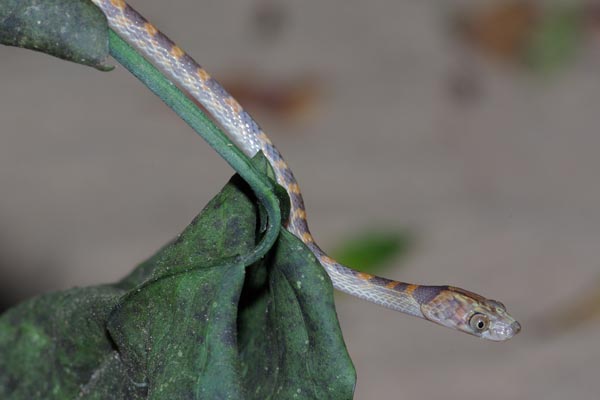
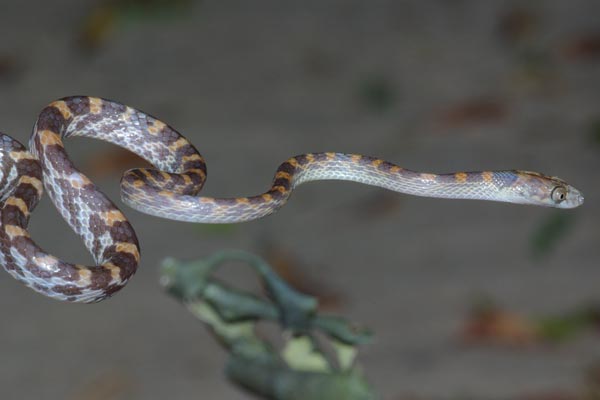
Finally, here are a few of the non-herps we saw at Anjajavy.
My sister really wanted to see some of the famous Madagascar hissing cockroaches while we were in the country, and Anjajavy did not disappoint. We saw a number of them crawling around on the ground, and found a swarm of them slowly scuttling about on a tree under some loose bark.
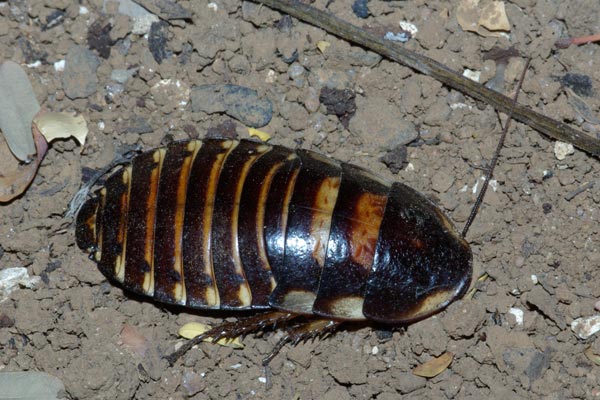
Near the pond o' frogs and frog-eating snakes, we came across a large and powerful rhinoceros beetle. Well, it probably used to be powerful -- it was actually lying on its back when we discovered it, and was in fact bereft of life. Still, pretty imposing-looking for a dead beetle.
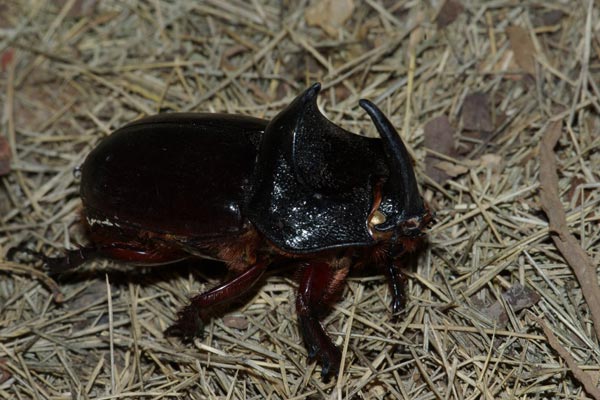
Flittering about in the forest were these beautiful moths that could easily be mistaken for butterflies. Their thick bodies were the only thing that gave away their moth-nature.
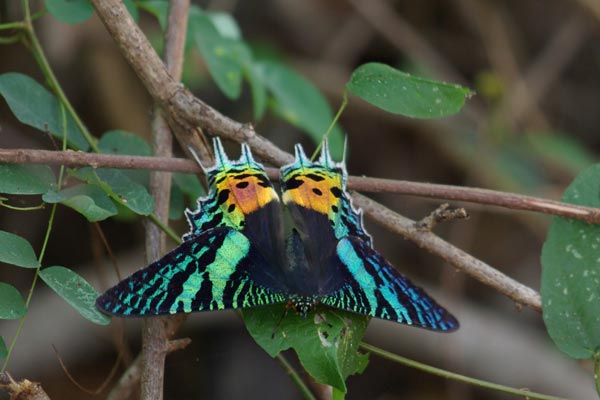
One morning when we were taking a pre-breakfast beach stroll we saw this raptor surveying its territory. I think this is a Madagascar Fish Eagle, Haliaeetus vociferoides.
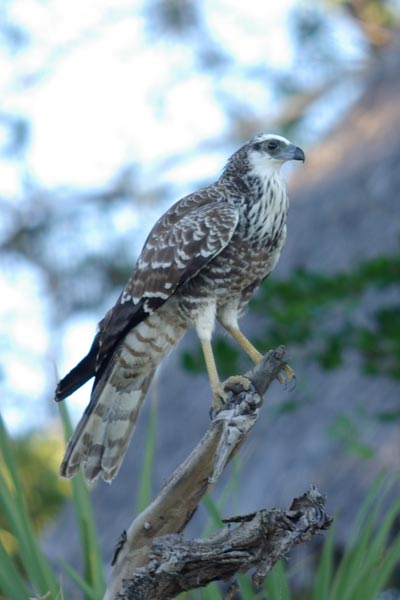
While we were frogging at the pond, we were surprised to see a small rodent climbing among the reeds in the pond. This could possibly be some uninteresting introduced rodent, but I think it's the native species Macrotarsomys bastardi.
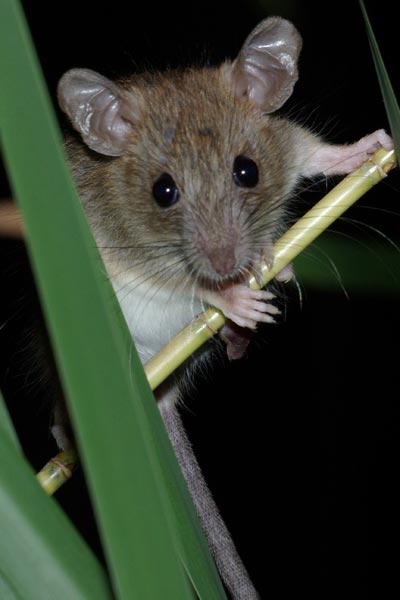
At night we saw much eye-shine from small lemurs at a distance. This is the only photo I got of one of these nocturnal lemurs. I think this is Coquerel's Giant Mouse Lemur.
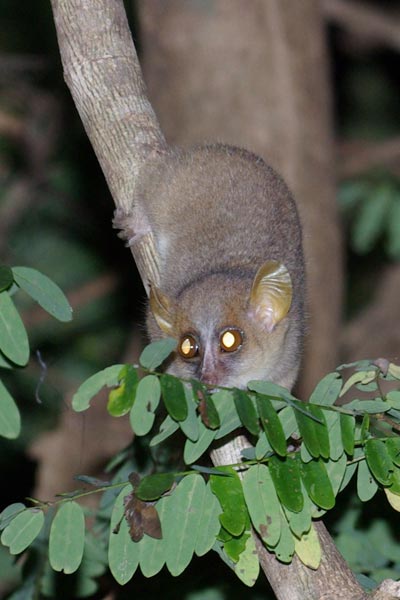
The Common Brown Lemur was one of the two lemur species that were easy to see at the right times of day near the main resort area, especially in and near the gardens.
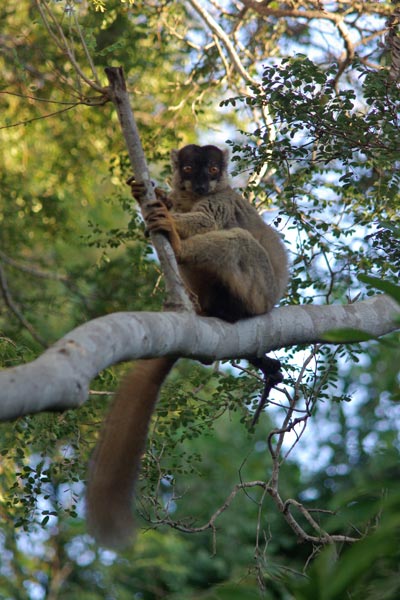
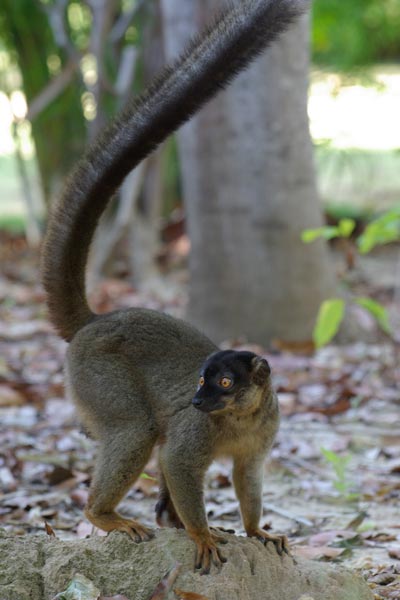
The other lemur species that would visit the Anjajavy gardens regularly was the beautiful Coquerel's Sifaka. Like other sifakas, these lemurs are extremely graceful in the trees and extremely awkward on the ground. They look like people dressed in cute furry animal costumes.
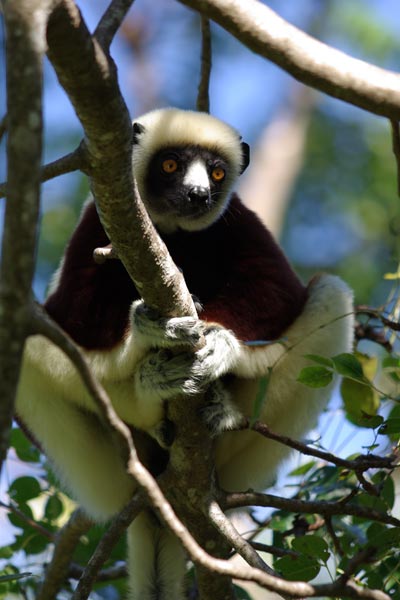
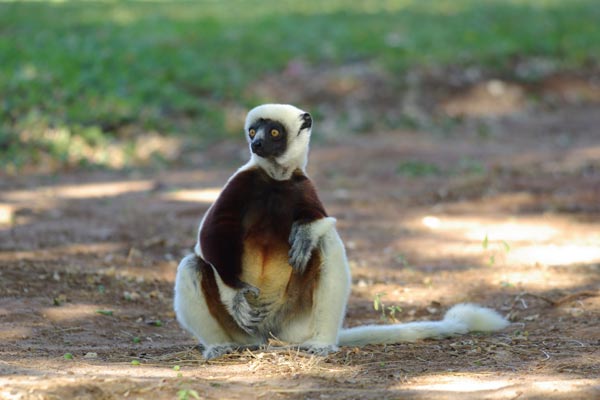
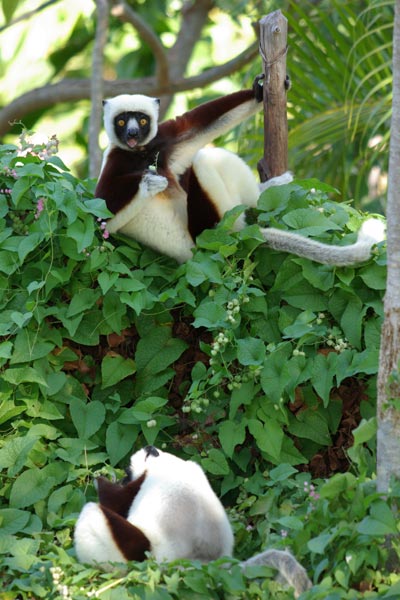
John Sullivan
June 27, 2007
P.S. I haven't updated this story with taxonomic changes or corrections, but my complete herp list for this trip has been updated as I've learned more. The 3rd edition of Glaw and Vences did eventually get published and make its way into my hands, and it was indeed replete with taxonomic changes.